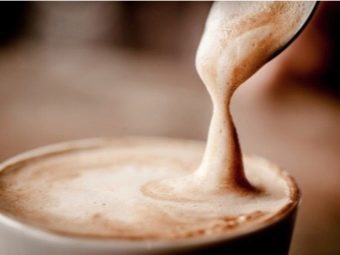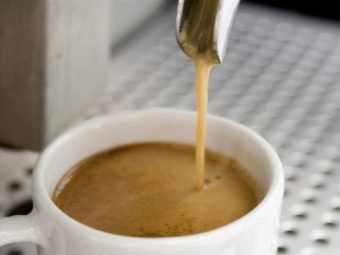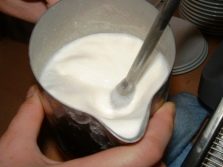Cappuccino coffee: composition and cooking technology

Among the variety of ways to make coffee, cappuccino is one of the most popular these days.His gentle, pleasant and rich taste is undoubtedly familiar to any lover of the invigorating drink, but not everyone knows how to properly prepare and serve it. Therefore it is worth considering the features, composition, types and technology of making cappuccino.
A bit of history
Everyone knows that cappuccino is a coffee with a nice milky creamy foam. But few know where this drink came from and what is the origin of its name.
The first scattered references to the method of preparing a drink from coffee beans with the addition of milk or cream date back to the 17th century. Despite the Italian etymology and the sound of the word "cappuccino", the first drink of this kind began in Vienna in the 18th century, then the coffee capital of the world. Such a drink was called “Kapuziner”, which went back to the Italian word “Cappuccino”, which meant “hood” or “Capuchin monk”. It is with this Italian monastic order that it is customary to associate the origin of cappuccino as a type of hot beverage.
There are three main versions that connect cappuccino coffee with capuchin. According to one of them, the least likely, but the most poetic version, the monks themselves invented this drink to repaint black, which is associated with the devil, coffee in a more pious color, and at the same time sweeten its bitter taste. Most of these legends associate cappuccino with Honored Capuchin Monk Marco d'Aviano, who lived from 1631 to 1699. However, serious historical sources do not associate the monastic order or its specific representatives with any changes in the invigorating drink recipe. In addition, one of the main vows of this order was poverty, so it is doubtful that the monks could spend the few monastic gold on purchases of coffee beans that were quite expensive at that time.
The second version says that the name of the cappuccino was given in honor of its light brown color, which the Habits had at that time - the robe of Capuchin monks. Finally, the third, and the most plausible from the point of view of coffee historians, claims that the “cap” formed during the preparation of cappuccino from a milky creamy foam resembled the hood of the Capuchins, in honor of which they received at first the people's and then the official name of their order.
Anyway, the legend that originated in Italy (and, most likely, the recipe connected with it) was leaked to Austria, which then owned a considerable part of the Italian lands, and was used by the enterprising barista of those times to increase their sales. Even if the cappuccino was really first invented in Italy, all the glory and profits went to the owners of Viennese coffee houses. Moreover, the first mention of the word “cappuccino” in the familiar Italian-language form is dated only to the beginning of the 20th century, until then the German word “Kapuziner” was used for the versions of invigorating drink containing milk or cream.
After centuries, historical justice still triumphed, and today all culinary reference books and coffee experts refer cappuccino to Italian cuisine.
Special features
The most important feature of cappuccino is the presence of dense and thick milk or creamy foam, which must withstand for some time even sugar poured on it. In this case, the foam should not be dissolved or mixed with the bottom layer of the drink.
The main difference between cappuccino and most other milk-coffee recipes is its taste and proportions of ingredients. Of all the existing varieties of such drinks, only macchiato contains a large proportion of coffee. From all other recipes based on coffee and milk, including latte, mokkachino, coffee with milk and raff coffee, cappuccino has a greater share, in fact, coffee. Due to this, the drink has a characteristic pleasant aroma and a tart, rich taste with a characteristic nutty touch of espresso.In other words, cappuccino is a way of making an espresso with milk froth, while a latte is a milk-coffee cocktail.
In addition, unlike other, less stringent recipes, for the cappuccino is strictly regulated and the composition and method of preparation. Various variations of this hot beverage can only be obtained by adding additional ingredients in relatively small quantities.
Only strictly adhering to the technology of preparation, you can achieve the very taste and aroma that distinguish cappuccino from all other invigorating drinks.
Although the presence of milk softens the taste of an invigorating drink, it still contains a fairly decent amount of caffeine (from 50 to 80 mg per cup depending on the type of coffee used), therefore pregnant women and nursing mothers, children and those with serious heart diseases vascular system should refrain from using cappuccino. Do not use it and people suffering from various forms of lactose intolerance or diabetes. The efficacy of certain drugs in combination with coffee drinks may also decrease.
But for people with low blood pressure, invigorating drink helps to normalize it and dilate blood vessels. In addition, flavored drink helps to normalize the function of the digestive system, stimulates the heart and contains many nutrients - first of all it is calcium, iron, magnesium, selenium, pyridine and some vitamins, for example, A, C, PP and E.
Composition and calorie
The classic cappuccino recipe includes only two main ingredients:
- Of course, the basis of this drink is espresso coffee after careful straining (after all, thick in a cappuccino is unacceptable);
- The basis for the foam is milk, which must be whipped until half of its volume foams.
Additionally, the composition of the drink may include:
- To increase the sweetness of the drink, you can add one or two teaspoons of sugar to it;
- additives - serve to improve the taste, usually vanilla or special flavored syrups are used;
- powdered toppings for the crema - most often cinnamon, grated chocolate or cocoa plays their role, which can be further mixed with powdered sugar.
In terms of proportions, an espresso should occupy a third of the volume of a cup of a drink, another third will be liquid milk, and the last third will be taken by a rolling milk cream. Thus, for 1 standard cup of 200 ml you will need 100 grams of milk (or 50 grams of milk and cream), 100 grams of water and two teaspoons of ground black coffee.
Due to the content of milk (and especially cream), the energy value of cappuccino is much higher than that of regular espresso or americano. So, the usual cup of cappuccino with a volume of 200 ml, prepared with milk fat content of 2.5%, will have a caloric content of 72 kilocalories. If you use milk with a fat content of 3.2%, the resulting drink will have an energy value of 82 kcal already.
The use of equal proportions of milk and cream will increase the caloric content to a solid 120 kilocalories, and adding even a cappuccino of low-fat milk-based cappuccino will result in an increase in caloric content up to 100 kcal. Finally, the combination of sugar and various toppings brings the energy value of the resulting flavored drink to as much as 134 kcal. If you add to this drink also various sweet syrups, the caloric content can exceed 150 Kcal.
Therefore, figure followers should not abuse this invigorating drink, especially in combination with sugar and various additives.
Kinds
The sequence of adding ingredients distinguish two main types of cappuccino:
- white - the most common option, when milk foam is applied over the espresso;
- the black - a much more rare form in which milk froth is first prepared at the bottom of the glass, and only then a layer of coffee is carefully (to prevent mixing).
Both of these options differ only aesthetically, their taste when properly prepared should be the same.
According to the method of preparing the coffee base, such flavored drink variants are distinguished:
- cooked in a coffee machine - is considered the most correct option, facilitates most of the manipulations, in all the coffee houses you are most likely waiting for this option;
- brewed in the Turk - does not differ in taste from the previous version, but requires greater caution and thoroughness in cooking;
- made from instant coffee - significantly inferior to the brewed variant in taste and aroma;
- prepared from a sachet a la 3 in 1 and the like - many believe that such a drink is generally not worthy of being called a cappuccino, so it can only be considered if all other options are unavailable.
Like most coffee recipes, cappuccino is also classified by recipe:
- classical - contains only coffee and milk or creamy foam, a small amount of sugar and toppings are allowed;
- double cappuccino - by analogy with double espresso is a doubled portion of the usual, allowed to increase the coffee content while maintaining the amount of milk, the resulting drink to taste will be closer to macchiato, but will retain the characteristic "hill" of foam on the surface;
- ice cappuccino - an option for hot summer days, the recipe is complemented by ice cubes or is made on the basis of frozen espresso;
- with chocolate - the classic version with chocolate topping;
- cinnamon - distinguished by the use of cinnamon as a sprinkle;
- Viennese cappuccino - the classic version in which cinnamon and chocolate are used as topping;
- cappuccino with vanilla - egg yolk and vanilla are added to the composition;
- with ice cream - As an additive, ice cream dissolved in an espresso is used.
There are also alcoholic variations of this invigorating drink, among which the most common are:
- Irish Cappuccino - liqueur and nutmeg are also included;
- with cognac - Cognac is used as an additive, chocolate is added to shade its taste.
How to cook?
Even at home, a classic cappuccino, like all its variations, is easiest to do with a coffee machine. For this you need to cook an ordinary espresso. Warm up the coffee machine, steam off, pour the milk into a large cup and dip the cappuccino maker in it, open the tap, beat the milk until a thick froth appears, then pour the espresso into the porcelain cup, add the third of the fresh milk from the top and top with the spoon gently spread the milk froth. Properly added foam layer should not only be flush with the edge of the cup, but also stand for it, especially in the center. Your cappuccino is ready, you can add sugar or toppings to it.
If you do not have a coffee machine at home, you can make a strong espresso in a cezve (Turk) or a French press, and it is recommended to boil it for a rich taste and proper strength twice or three times. Then you need to slightly warm the milk (but in no case do not boil, the best temperature is from 65 to 75 ° C) and beat it with a blender, an electric mixer or a French press.
In the absence of these units, you can try to get the foam using a whisk or spoon, but this process will require considerable effort and more time. The resulting foam, as in the case of using the coffee machine, you need to shift with a spoon in a glass of espresso and milk.
If you are interested in a cappuccino recipe with chocolate, then keep in mind that in order to retain chocolate particles for a long time, the foam should be even thicker than in the classic recipe. Therefore, take 50 ml of full-fat milk and cream, it will help to strengthen the foam layer.Next, prepare a classic cappuccino, rub on a grater to 1 tsp of chocolate to taste and sprinkle with chocolate chips the foam layer of the drink. The resulting drink will have an elegant combination of espresso, milk and chocolate flavors.
To make a fragrant cinnamon drink, prepare a classic version. Grind the cinnamon with a coffee grinder, a kitchen grinder or, as a last resort, a rolling pin, then carefully pour it over the top of the foam layer. One stick of cinnamon can be gently inserted into the resulting drink to decorate it.
The Viennese cappuccino preparation is essentially a combination of the two previous recipes, only the order of filling the container changes slightly - first warm milk is poured into the glass, espresso is added on top, milk foam is applied on top, and chocolate cinnamon and cinnamon are sprinkled on top.
Cinnamon and chocolate chips are allowed for many other invigorating drink recipes, including ice and double cappuccino.
When making vanilla variations, the foam is already made from a pre-cooked mixture of 3 grams of vanilla, one egg yolk and 30-40 grams of powdered sugar. Further operations are performed according to the classic version - a layer of espresso, a layer of milk, a layer of the resulting vanilla-milk froth.
To make an ice cream drink, prepare a standard 100 ml espresso for cappuccino, pour them into a cup, add up to 50 g of an ordinary white ice cream (although other ice cream options will do, just the taste of the additives included in them is likely to be lost among the other shades of coffee beverage ), and on top of it, apply pre-cooked milk froth.
Making Irish Cappuccino differs from most other methods in that the first layer in the glass will be a layer of 25-50 ml of liquor (“Baileys” or “Sheridans” is best), on top of which espresso and milk are poured. A foam is applied on top, which is sprinkled with grated nutmegs (15 grams will suffice).
To make cappuccino with brandy, you will need 25-50 grams of brandy and 20 grams of white and black chocolate. At the same time, white chocolate must be melted and mixed with espresso. Cognac is poured into a container on top of a layer of coffee, a layer of froth is put on top, and ground black chocolate is used as topping.
What to serve and how to drink?
What a cappuccino recipe you would not have prepared, it still needs to be properly served to the table.
The drink is served exclusively in the hot state (except, of course, an ice-recipe), the ideal temperature for it is 70 ° C.
This aromatic drink is poured exclusively into pre-heated thick-walled porcelain or ceramic cups up to 220 ml with slightly rounded top edges. It is allowed to serve in transparent glass cups, usually used for Irish coffee, because they clearly show the thickness of the foam. You can heat the cup to the correct temperature, for example, by rinsing it with boiling water, pouring hot steam on it or using a special cup heater. In order for the cappuccino layers not to spill out when they are subsequently added to the container, the internal shape of the correct coffee cup must be egg-shaped, and the walls themselves must be as even as possible.
Before serving, it is considered to be very good to apply some beautiful pattern (most often a heart, a flower, a leaf, an apple) to the surface of the foam with the help of cinnamon, chocolate, powdered sugar or other toppings.
Many people believe that if a drawing is not applied in a coffee shop when serving cappuccino, then such an institution is absolutely unworthy to visit. The art of drawing such drawings is called latte art. To foam and drawings on it were clearly visible, the glass should slightly expand to the top, and ideally have the shape of a truncated bottom cone.
So, drink on the table - now you need to drink it correctly.Cappuccino is drunk exclusively through the foam layer - either with the help of a straw, or with careful small sips over the edge of the cup. In any case, the layers of the drink in no case should not be mixed. Foam is eaten with a teaspoon, usually after you finish the coffee. In general, it is allowed to remove the foam with a spoon before drinking an invigorating drink, although some particularly conservative barista may consider this unacceptable.
Cappuccino is quite tasty in itself, but in its homeland, in Italy, it is most often used at breakfast, therefore it is usually supplemented with a small bun or a croissant. Italians believe that cappuccino is too high in calories, so they drink it only until 11 am, and at a later time they prefer espresso. Although in general, the most important thing is not to abuse this drink, which contains both caffeine and a lot of calories - so at least you should not drink it before bedtime.
In addition to buns, a very well-flavored drink is combined with donuts or desserts containing chocolate and / or butter cream — various cakes, brownies, tiramisu, cookies, and sweets.
Little tricks
Remember that sugar in cappuccino is added exclusively on top of the foam layer and nothing else. But the flavoring syrups need to be added directly to the espresso, and not to the mixture of coffee and milk, and the more you do not need to pour them on top through the foam. The use of flavors on top of the foam layer is allowed only in the case of latte art, when you want to create a multi-colored pattern with them. But in this case, their dosage should be minimal so that they do not push through the layer of foam.
It is easiest to apply drawings to the surface of the foam using a special stencil, through which toppings will pour. Smaller details can be created using a fine toothpick.
You can control the saturation of the coffee taste in a drink using the coffee preparation mode - if it boils, especially several times, the drink will be more bitter and stronger. Not bringing the espresso to a boil can achieve a delicate and sweet taste of the drink.
Usually, the fatter the milk used to make a drink, the more delicious it will eventually be, and it is easier to beat the foam from the more fat milk.
If you do not have a cappuccinator, and you really want to get a high-quality foam, try mixing milk with a small amount of cream, this will significantly increase its foaming.
If you want to reduce the amount of caffeine in the resulting drink, then instead of Robusta in its preparation, use arabica.
Despite the rigor of recipes flavored drink, you are free to experiment with toppings. And remember that the best cappuccino is a cappuccino made with love!
To learn how to make cappuccino at home, see the following video.

































































